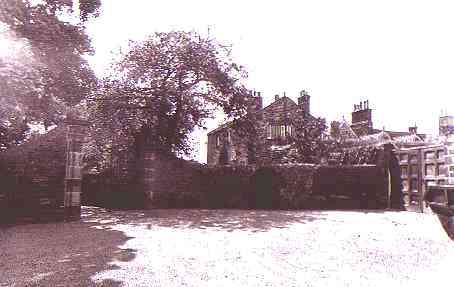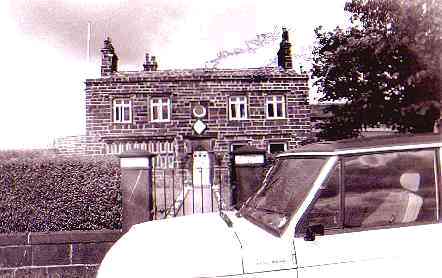This rather remote section of the woods is bounded by Delf Hill on the one side and by Royds Hall on the other. All paths through it eventually come out by the seat at Royds Hall Lane, from which there is an excellent view.
The origin of the wood's name is curious. The only connection I can find is that James Hanson of nearby Woodside Farm married Ann, daughter of John and Hannah Wood in 1729, which would be about the time the wood was planted, judging by the maturity of the trees. Perhaps the mother was widowed and lived with her son at Woodside. We can only speculate.
After passing through old Hanna Wood we eventually emerge into Royds Hall Lane, by the seat from which a sweep of hills stretching to the boundaries of Derbyshire, Cheshire and Lancashire may be observed. Below us, on the other side of the woods is Norwood Green and its clocktower, beyond which the eye is carried up to the commanding tower of Coley Church, with Halifax Beacon behind, topped by its little white house. Further afield, the ornate top of the Wainhouse Tower may be seen, poking up from the Calder Valley. Other landmarks include Fosters Mill at Queensbury, Reevy Beacon, the Emley Moor Transmitter, and the Jubilee Tower on Castle Hill above Huddersfield. The prospect is truly impressive.
Continuing onwards the track bears left, by what used to be the Low Moor Steelwork's cricket field, now given over to equestrian pursuits. On the right, Delf Hill comes into view, crowned by its white triangulation pillar. Soon we can see Low Moor, Wibsey and Buttershaw, now an urban area
of Bradford stretching away to the police transmitter on the summit of tree capped Reevy Beacon. Below us, on the right, are the flats of the Woodside Estate. The track leads unerringly to
ROYDS HALL.

ROYDS HALL
The old manor house of Royds Hall, the residence of the Lords of the Manor of North Bierley and Wibsey is situated on high table land over 700 feet above sea level. A very fine specimen of the type of house built by the gentry during the reign of James I, Royds Hall must be one of the finest residences in the Bradford Area. History relates that up to the year 1307 the Lord of the Manor of Royds Hall was William De Swillington. He left no heir, and after a short succession of owners the Hall and its estates passed to William Rookes of Rookes Hall, Norwood Green, who became tenant in the early 14th century, and whose line held the property up to 1789, at which point the lands passed to the Low Moor Iron Company. Thus it was that the Rookes and Royds Hall became synonymous with each other. Rooks are to be found on their armorial bearings, and the grounds of the hall are bounded by extensive rookeries. Looking at the great flocks of black birds that nest here, one almost fancies that the souls of that illustrious family still dwell within the rooks that swoop around their beloved Royds Hall as did their winged ancestors of yore!
In 1640 the Rookes rebuilt the mansion, as shown by the date over one of the doorways. In 1641 the Civil War loomed. Naturally enough, the Rookes supported the cause of the King. The subsequent decline and persecution of the Royalists during the Interregnum also marked a decline in the fortunes of the Rookes family. This brings us to an interesting story of buried treasure. In the eighteenth century, when Edward Rookes Leedes was the last squire at Royds Hall, a man was ploughing on land belonging to Woodside Farm when he came across a large earthenware jar filled with gold coins of the reigns of Mary, Elizabeth, James I and Charles I. This was obviously wealth that the Rookes had hidden from the roundheads, wealth that William Rookes no doubt conveniently forgot to mention when his estates were under sequestration in 1647. There is a record in existence of the rents and personal properties he delivered to the Cromwellian commissioners who attended the Old Dolphin Inn at Clayton Heights. There was no mention of any buried treasure there! Rather more recently, a man with a metal detector discovered another jar (this time of silver coins) in Judy Woods. This involved him in a bitter struggle with Bradford Metropolitan Council, who claimed (unsuccessfully) that the treasure was rightfully theirs, the find being made on council land. Perhaps more treasure waits to be found. Who knows?
The Rookes family passed away from Royds Hall with the death of old Squire Leedes. He was a Justice of the Peace and was involved in the interrogation of witnesses concerning the activities of the Cragg Vale Coiners. He held court at Royds Hall, and his courtroom still remains, the ancient manorial court of Wibsey. The squire, it seems was something of an eccentric, and many humourous tales are told of him. One story tells of an old man named Pearson, who lost his mule, and having got wind of the missing animal and also of the thief, went up to Royds Hall to consult the squire as to whether he should 'fetch law' to get the animal back again. 'Law? Law?' said the squire, 'there's no law for a donkey!' 'Isn't there?' said old Pearson, 'Well then, I'll help mysen to t'best donkey ah can find on t'common as ah goa hoam!' 'Stop! stop!' cried the squire 'I'll give thee a warrant!'
Poor squire Leedes met a rather sad end. Hopelessly ensnared in debts and difficulties he shot himself while travelling from Royds Hall in his carriage. He had been Justice, and Lord of the rich manors of North Bierley and Wibsey. To him, the mineral wealth beneath his broad acres was an unknown quantity and it fell to others with greater energy and resources to reap the rich harvest of coal and iron.
Squire Rookes Leedes died in 1787, the last of his line. In 1788, the manor was purchased by Messrs. Hird, Dawson, Jarratt and Hardy of the Low Moor Iron Company. Royds Hall became the residence of Mr. Joseph Dawson, one of the partners. He was friend of Priestley, the scientist, who discovered oxygen, and many of Priestley's experimentations took place at Royds Hall. Since those days the house has had a succession of owners.
From Royds Hall the farm road leads down to Woodside Estate, which it joins at the top of Lingdale Road. Our route however, passes through a stile on the left, just as the road starts to descend from Royds Hall. We pass through a field beneath pylons, next passing alongside the top of NORTH BROW WOOD, a small plantation which stands behind the (now sacriligiously demolished!) Woodside Youth Centre. In the field on the left a grassy mound marks the site of an old mineshaft. On reaching the new housing just beyond, we bear left across the field back into the top of Judy Woods. Descend to the beck, ascend the 'Snoddy' and retrace the outward route back to the start of our perambulation at Riding Hill Bridge and Manorley Lane.
This walk is only a suggested route. Other options are available. Judy Woods may be tackled in a number of directions from a number of points. It may be shortened or lengthened according to preference. Beyond Norwood Green the belt of countryside stretches to the Shelf woodlands, to Coley Hall with its lovely old gateway, or to Priestley Green with its 'Sisters House' beloved of painters. The area is passed through by the Calderdale Way, which provides footpath access to the very heart of the South Pennine Park. The Calderdale Way however, (being created by Calderdale Council) avoids Bradford-owned Judy Woods completely, and it is quite possible to walk through Norwood Green happily unaware of the fine sweep of mature woodlands that lie to its east. It is hoped that this booklet will remedy ignorance of the delights of 'Judy Woods' and encourage walkers to come and explore this fine and relatively uhnknown area of broadleaved woodlands. Judy woods awaits..........

HIGH FERNLEY HALL
Previous Page





copyright © Jim Jarratt 2002
The old manor house of Royds Hall, the residence of the Lords of the Manor of North Bierley and Wibsey is situated on high table land over 700 feet above sea level. A very fine specimen of the type of house built by the gentry during the reign of James I, Royds Hall must be one of the finest residences in the Bradford Area. History relates that up to the year 1307 the Lord of the Manor of Royds Hall was William De Swillington. He left no heir, and after a short succession of owners the Hall and its estates passed to William Rookes of Rookes Hall, Norwood Green, who became tenant in the early 14th century, and whose line held the property up to 1789, at which point the lands passed to the Low Moor Iron Company. Thus it was that the Rookes and Royds Hall became synonymous with each other. Rooks are to be found on their armorial bearings, and the grounds of the hall are bounded by extensive rookeries. Looking at the great flocks of black birds that nest here, one almost fancies that the souls of that illustrious family still dwell within the rooks that swoop around their beloved Royds Hall as did their winged ancestors of yore!
In 1640 the Rookes rebuilt the mansion, as shown by the date over one of the doorways. In 1641 the Civil War loomed. Naturally enough, the Rookes supported the cause of the King. The subsequent decline and persecution of the Royalists during the Interregnum also marked a decline in the fortunes of the Rookes family. This brings us to an interesting story of buried treasure. In the eighteenth century, when Edward Rookes Leedes was the last squire at Royds Hall, a man was ploughing on land belonging to Woodside Farm when he came across a large earthenware jar filled with gold coins of the reigns of Mary, Elizabeth, James I and Charles I. This was obviously wealth that the Rookes had hidden from the roundheads, wealth that William Rookes no doubt conveniently forgot to mention when his estates were under sequestration in 1647. There is a record in existence of the rents and personal properties he delivered to the Cromwellian commissioners who attended the Old Dolphin Inn at Clayton Heights. There was no mention of any buried treasure there! Rather more recently, a man with a metal detector discovered another jar (this time of silver coins) in Judy Woods. This involved him in a bitter struggle with Bradford Metropolitan Council, who claimed (unsuccessfully) that the treasure was rightfully theirs, the find being made on council land. Perhaps more treasure waits to be found. Who knows?
The Rookes family passed away from Royds Hall with the death of old Squire Leedes. He was a Justice of the Peace and was involved in the interrogation of witnesses concerning the activities of the Cragg Vale Coiners. He held court at Royds Hall, and his courtroom still remains, the ancient manorial court of Wibsey. The squire, it seems was something of an eccentric, and many humourous tales are told of him. One story tells of an old man named Pearson, who lost his mule, and having got wind of the missing animal and also of the thief, went up to Royds Hall to consult the squire as to whether he should 'fetch law' to get the animal back again. 'Law? Law?' said the squire, 'there's no law for a donkey!' 'Isn't there?' said old Pearson, 'Well then, I'll help mysen to t'best donkey ah can find on t'common as ah goa hoam!' 'Stop! stop!' cried the squire 'I'll give thee a warrant!'
Poor squire Leedes met a rather sad end. Hopelessly ensnared in debts and difficulties he shot himself while travelling from Royds Hall in his carriage. He had been Justice, and Lord of the rich manors of North Bierley and Wibsey. To him, the mineral wealth beneath his broad acres was an unknown quantity and it fell to others with greater energy and resources to reap the rich harvest of coal and iron.
Squire Rookes Leedes died in 1787, the last of his line. In 1788, the manor was purchased by Messrs. Hird, Dawson, Jarratt and Hardy of the Low Moor Iron Company. Royds Hall became the residence of Mr. Joseph Dawson, one of the partners. He was friend of Priestley, the scientist, who discovered oxygen, and many of Priestley's experimentations took place at Royds Hall. Since those days the house has had a succession of owners.
From Royds Hall the farm road leads down to Woodside Estate, which it joins at the top of Lingdale Road. Our route however, passes through a stile on the left, just as the road starts to descend from Royds Hall. We pass through a field beneath pylons, next passing alongside the top of NORTH BROW WOOD, a small plantation which stands behind the (now sacriligiously demolished!) Woodside Youth Centre. In the field on the left a grassy mound marks the site of an old mineshaft. On reaching the new housing just beyond, we bear left across the field back into the top of Judy Woods. Descend to the beck, ascend the 'Snoddy' and retrace the outward route back to the start of our perambulation at Riding Hill Bridge and Manorley Lane.
This walk is only a suggested route. Other options are available. Judy Woods may be tackled in a number of directions from a number of points. It may be shortened or lengthened according to preference. Beyond Norwood Green the belt of countryside stretches to the Shelf woodlands, to Coley Hall with its lovely old gateway, or to Priestley Green with its 'Sisters House' beloved of painters. The area is passed through by the Calderdale Way, which provides footpath access to the very heart of the South Pennine Park. The Calderdale Way however, (being created by Calderdale Council) avoids Bradford-owned Judy Woods completely, and it is quite possible to walk through Norwood Green happily unaware of the fine sweep of mature woodlands that lie to its east. It is hoped that this booklet will remedy ignorance of the delights of 'Judy Woods' and encourage walkers to come and explore this fine and relatively uhnknown area of broadleaved woodlands. Judy woods awaits..........

HIGH FERNLEY HALL
Previous Page





copyright © Jim Jarratt 2002
Previous Page





copyright © Jim Jarratt 2002